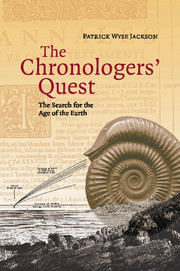Book contents
- Frontmatter
- Contents
- List of illustrations
- List of tables
- Preface
- Acknowledgements
- 1 The ancients: early chronologies
- 2 Biblical calculations
- 3 Models of Aristotelian infinity and sacred theories of the Earth
- 4 Falling stones, salty oceans, and evaporating waters: early empirical measurements of the age of the Earth
- 5 Thinking in layers: early ideas in stratigraphy
- 6 An infinite and cyclical Earth and religious orthodoxy
- 7 The cooling Earth
- 8 Stratigraphical laws, uniformitarianism and the development of the geological column
- 9 ‘Formed stones’ and their subsequent role in biostratigraphy and evolutionary theory
- 10 The hour-glass of accumulated or denuded sediments
- 11 Thermodynamics and the cooling Earth revisited
- 12 Oceanic salination reconsidered
- 13 Radioactivity: invisible geochronometers
- 14 The Universal problem and Duck Soup
- Bibliography
- Index
9 - ‘Formed stones’ and their subsequent role in biostratigraphy and evolutionary theory
Published online by Cambridge University Press: 02 December 2009
- Frontmatter
- Contents
- List of illustrations
- List of tables
- Preface
- Acknowledgements
- 1 The ancients: early chronologies
- 2 Biblical calculations
- 3 Models of Aristotelian infinity and sacred theories of the Earth
- 4 Falling stones, salty oceans, and evaporating waters: early empirical measurements of the age of the Earth
- 5 Thinking in layers: early ideas in stratigraphy
- 6 An infinite and cyclical Earth and religious orthodoxy
- 7 The cooling Earth
- 8 Stratigraphical laws, uniformitarianism and the development of the geological column
- 9 ‘Formed stones’ and their subsequent role in biostratigraphy and evolutionary theory
- 10 The hour-glass of accumulated or denuded sediments
- 11 Thermodynamics and the cooling Earth revisited
- 12 Oceanic salination reconsidered
- 13 Radioactivity: invisible geochronometers
- 14 The Universal problem and Duck Soup
- Bibliography
- Index
Summary
Fossils are the remains of plants and animals that are preserved in rock. The oldest evidence for life comes from carbon found in rocks on the island of Akilia in southern Greenland that have been dated as being 3,850 million years old. Some authorities have argued that this date is inflated, and that the rocks are in fact 150 to 200 million years younger. Worse still, they have been interpreted as being a banded ironstone, which would indicate that the carbon was not organic. The oldest undisputed fossils are thought to be blue-green algal filaments found in the Apex chert in Western Australia, which are 3,465 million years old. For many millennia, fossils have been the focus of curiosity, but only in the past 150 years have fossils been systematically studied and described. They are useful tools in dating the geological past and have also been used to correlate sequences of rock from area to area, locally or even from continent to continent. The discipline of studying fossils is called palaeontology.
Our understanding of what fossils are and what they can tell us is continually evolving. This is what makes the subject so interesting. Research on fossils is always changing and new methodologies appear every year to test new ideas or re-evaluate old hypotheses. Twenty years ago, it was unheard of to use sophisticated instruments such as mass spectrometers to measure the ratios of the various oxygen isotopes trapped within fossil skeletons, which yield information about the temperature of the sea water from which the skeleton was precipitated.
- Type
- Chapter
- Information
- The Chronologers' QuestThe Search for the Age of the Earth, pp. 154 - 170Publisher: Cambridge University PressPrint publication year: 2006



